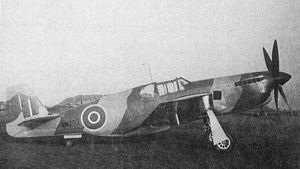Rolls-Royce Mustang Mk.X
| Mustang Mk.X | |
|---|---|
 |
|
| Mustang Mk X AM203 in the third configuration tested with a high-speed paint finish applied by Sanderson and Holmes, the coachbuilders in Derby, UK. | |
| Role | Experimental aircraft |
| Manufacturer | Rolls-Royce |
| First flight | 13 October 1942 |
| Introduction | experimental |
| Primary users |
Royal Air Force United States Army Air Forces |
| Number built | 5 |
| Developed from | P-51 Mustang |
The North American Mustang Mk.X (as in "Mark.10"; also known as the "Rolls-Royce Mustang") was a British variant of the US North American P-51 Mustang using a Rolls-Royce Merlin engine in an experimental program established by the Rolls-Royce company in 1942.
In April 1942, the Royal Air Force's Air Fighting Development Unit (AFDU) tested the Allison V-1710-engined Mustang at higher altitudes and found it wanting, but their commanding officer, Wing Commander Ian Campbell-Orde, was so impressed with its maneuverability and low-altitude speed that he invited Ronald Harker from Rolls-Royce's Flight Test establishment to fly it.
It was quickly evident that performance, although exceptional up to 15,000 ft (4,572 m), was inadequate at higher altitudes. This deficiency was due largely to the single-stage supercharged Allison engine, which lacked power at higher altitudes. Still, the Mustang's advanced aerodynamics showed to advantage, as the Mustang Mk.I (P-51A) was about 30 mph (48 km/h) faster than contemporary Curtiss P-40 fighters using the same Allison powerplant. The Mustang Mk.I was 30 mph (48 km/h) faster than the Spitfire Mk VC at 5,000 ft (1,524 m) and 35 mph (56 km/h) faster at 15,000 ft (4,572 m), despite the latter having a significantly more powerful engine than the Mustang's Allison.
Rolls-Royce engineers rapidly concluded that the Mustang powered by a two-stage Merlin 61 would result in a significant improvement in performance and started converting five Mustangs to Merlin power as the "Mustang Mk.X" (i.e., Mk.10) With a minimum of modification to the engine bay, the Merlin engine neatly fitted into the adapted engine formers. A smooth engine cowling with a "chin" radiator was tried out in various configurations. The Merlin 65 series engine was utilized in all the prototypes as it was identical to the Merlin 66 powering the Spitfire Mk IX, allowing for a closer comparison. Due to the speed of the conversions, engines were often swapped from aircraft to aircraft as well as being replaced by newer units.
...
Wikipedia
